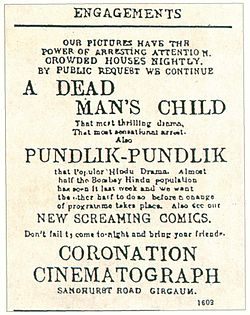Shree Pundalik
This article has multiple issues. Please help improve it or discuss these issues on the talk page. (Learn how and when to remove these template messages)
|
| Shree Pundalik | |
|---|---|
 Advertisement in The Times of India of 25 May 1912 announcing the screening of the first feature film of India, Pundalik, by Dadasaheb Torne | |
| Directed by | Dadasaheb Torne |
| Produced by | Dadasaheb Torne |
Release date |
|
| Country | India |
| Language | Silent |
Shree Pundalik, which was released on 18 May 1912 at the Coronation Cinematograph, Girgaum, Mumbai, is recognised as the first feature-length Indian film.[1][2][3] Shree Pundalik was produced and directed by Dadasaheb Torne alias Rama Chandra Gopal.
History[edit | edit source]
Pundalik was a silent film without dialogue. Torne and his colleagues Nanasaheb Chitre and Ramrao Kirtikar wrote the shooting script.
Shree Pundalik was sent overseas for processing by Dadasaheb Torne. Torne's Pundalik was about 1,500 feet or about 22 minutes long. The film had a shooting script, was shot with a camera, and its negatives were sent to London for processing. Positives were produced and finally released at Coronation Cinematograph, Girgaum. The film ran for two weeks.[4]
Debates about the film[edit | edit source]
Some have argued that Pundalik does not deserve the honour of being called the first Indian film because it was a photographic recording of a popular Marathi play, and because the cameraman—a man named Johnson—was a British national and the film was processed in London.[4][5] Detractors argue that Dadasaheb Phalke’s Raja Harishchandra, which was released nearly a year later, is more deserving of the title of the first Indian film.[4] However, other writers, film critics and historians like Firoze Rangoonwalla, Arnab Jan Deka, Sanjit Narwekar have argued that Dadasaheb Torne was indeed the father of Indian cinema, as his first directed and produced feature film Pundalik was officially released on 18 May 1912, almost one year before Phalke's Raja Harischandra, released on 3 May 1913. Arnab Jan Deka published a research paper with the title Bharatiya Chalachitrar Janak Bhatawdekar aru Torne (Fathers of Indian Cinema Bhatawdekar and Torne) in the daily newspaper Dainik Asam on 27 October 1996. Books on cinema like A Pictorial History of Indian Cinema and Marathi Cinema : In Perspective support the evidence produced by Arnab Jan Deka in his research paper.[1][2][3]
Centennial[edit | edit source]
Shree Pundalik celebrated its centennial on 18 May 2012.
References[edit | edit source]
- ↑ 1.0 1.1 Deka, Arnab Jan (27 October 1996). "Fathers of Indian Cinema Bhatawdekar and Torney". Dainik Asam (Assamese daily).
- ↑ 2.0 2.1 Narwekar, Sanjit (January 1995). Marathi Cinema : In Retrospect (1995 ed.). Bombay, India: Maharashtra Film, Stage & Cultural Development Corporation Ltd. pp. 9–12.
- ↑ 3.0 3.1 Rangoonwalla, Firoze (1979). A Pictorial History of Indian Cinema (1979 ed.). London, New York, Sydney, Toronto: The Hamlyn Publishing Group Limited. p. 12. ISBN 0-600-34909-8.
- ↑ 4.0 4.1 4.2 Mishra, Garima (3 May 2012). "Bid to get Pundalik recognition as first Indian feature film".
- ↑ Damle, Manjiri (21 April 2012). "Torne's 'Pundlik' came first, but missed honour". The Times of India. Archived from the original on 30 May 2013.